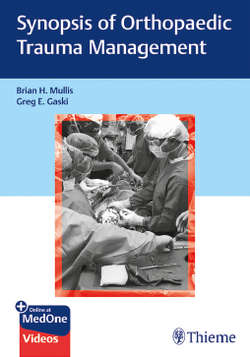Читать книгу Synopsis of Orthopaedic Trauma Management - Brian H. Mullis - Страница 69
На сайте Литреса книга снята с продажи.
II. Evaluation
ОглавлениеA. Advanced Trauma Life Support (ATLS) and physical examination.
1. Sixty percent of trauma patients have injuries to the musculoskeletal system.
B. Primary survey—it reveals obvious life- and limb-threatening injuries and begins the resuscitation process. Brief history from patient and/or EMS (age, mechanism, extrication time, fatalities at scene, obvious injuries and wounds) with simultaneous vital signs and airway, breathing, and circulation (ABC).
1. Airway:
a. Ability to protect airway.
b. Intubate the patient if necessary.
2. Breathing:
a. Measure respiratory rate, oxygenation.
b. Assess breath sounds and utilize needle decompression or chest tube as necessary.
3. Circulation:
a. Assess hemodynamic status and external sites of hemorrhage.
b. Apply pressure and dressings to wounds.
c. Utilize tourniquet for uncontrollable bleeding or mangled limbs.
d. Obtain intravenous access and begin fluid resuscitation.
4. Disability:
a. Perform a neurologic exam.
b. Glasgow Coma Scale.
5. Environmental exposure:
a. Remove all clothes and maintain patient body temperature.
b. Warm the trauma bay.
c. Use a fluid warmer and warm blankets.
6. Fractures:
a. Identify obvious injuries.
b. Apply splints/traction.
C. Secondary survey—it reveals less obvious injuries and requires vigilance and a head-to-toe exam.
D. History
1. Past medical history: identify relevant medical conditions that may impact early decision-making and/or benefit from optimization (if obtainable).
2. Past surgical history: relevant prior operations (if obtainable).
3. Allergies.
E. Physical exam
1. Complete visual inspection and examination.
2. Take down all dressings, remove tourniquets, and clothing.
3. Head-to-toe examination with palpation of all extremities including pelvis and spine.
4. Range all joints and perform a ligamentous examination of suspected injuries.
5. Vascular exam: palpate pulses in all extremities and utilize Doppler and ankle–brachial index (ABI) when indicated.
6. A lower limb with an ABI < 0.90 warrants additional investigation with either computed tomography (CT) angiogram, formal angiogram, or vascular consultation.
7. Motor and sensory examination with documentation.
8. Compartment syndrome—increased intracompartmental pressure causing decreased limb perfusion.
a. Identify injuries and patients at risk, and remain vigilant.
b. High-energy injuries, tibia fractures, forearm fractures, segmental injuries, open fractures, and severe swelling all should raise concern.
c. Diagnosis:
i. Accuracy of the traditional “5 Ps” (pain with passive stretch, paresthesias, paralysis, pulselessness, and pallor) has been questioned. Refer to Chapter 13, Acute Compartment Syndrome, for a more in-depth discussion.
ii. Typical exam findings include:
• Pain out of proportion.
• Pain with passive stretch of the muscle in the affected compartment.
• Paresthesias.
• Anesthesia or decreased sensation.
• Muscle weakness or paralysis.
• Tense compartment on palpation.
9. Tertiary examination in 48 to 72 hours once distracting injuries have been stabilized.
F. Imaging
1. Traditional—three radiographs are obtained urgently to aide in identifying life-threatening injuries: lateral cervical spine (c-spine), chest, anteroposterior pelvis.
Fig. 9.1 (a–c) Index case: Initial imaging and three-dimesional reconstructions of a 33-year-old male status post-industrial crush injury with open volume-expanding pelvic ring disruption and ipsilateral distal femur and tibial plateau fractures with vascular compromise.
2. Many trauma centers no longer obtain c-spine X-ray, as CT scan imaging can be performed quickly and can accurately identify injuries.
a. Less urgent imaging studies: X-rays of all injured or suspected injured skeletal structures above and below level of injury.
b. Any tenderness, swelling, crepitus, or skin break warrants further evaluation.
c. CT—2 mm fine cuts and three-dimensional reconstructions can improve diagnostic accuracy and assist in preoperative planning (▶Fig. 9.1).
3. Shock:
a. Hypovolemic—caused by hemorrhage and dehydration. Treatment includes control of hemorrhage and volume replacement.
b. Cardiogenic—caused by inability of heart to sustain circulation due to causes such as cardiac tamponade, aortic dissection, myocardial infarction, or dysrhythmia. Treatment includes inotropes or extracorporeal membrane oxygenation (ECMO).
c. Neurogenic—the loss of peripheral vascular tone secondary to spinal cord injury or traumatic brain injury. Treatment includes vasopressors and volume replacement.
d. Anaphylactic—an antigen–antibody reaction which causes distributive loss of circulatory volume. Treatment includes epinephrine and volume replacement.
e. Septic—the distributive loss of circulatory volume (peripheral vasodilation) secondary to infection and the resulting inflammatory response. Treatment includes antibiotics and volume replacement.
